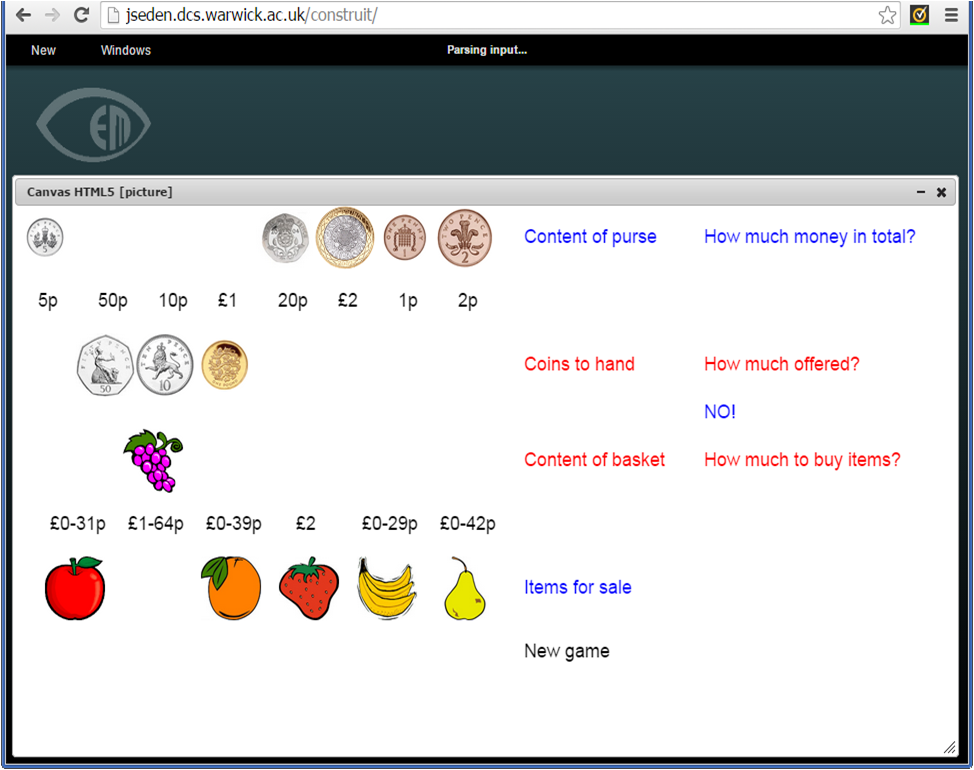Further adaptations of the shopping construal
The above discussion has illustrated how the basic shopping construal can be adapted to derive a standard educational game. Some further examples are introduced to demonstrate other potential adaptations and applications.
Construals in the broader educational context
The construal has educational value even without making its behaviour more constrained and game-like. By way of illustration, the basic shopping construal can be extended so that more of the relevant information about the shopping scenario can be accessed directly via the picture interface. For instance, in the screenshot below, the basic shopping construal has been extended - by copying-and-pasting the file oer1ext.js-e into the Input Window and pressing Submit - so that the answer to the question "has the customer offered enough money to buy the selected items" is displayed as YES/NO! on the picture. In addition, the answers to the key questions that concern the customer: "How much money do I have in total?", "How much money have I tendered?" and "How much does it cost to buy the selected items?" can be optionally displayed. For instance, to reveal the total amount of money that the customer has, it is only necessary to click on the text 'Content of purse'. In this way, the educator has easy access to an environment that can scaffold the learning - controlling what is explicitly exposed to the learner, and what the learner is expected to figure out for themselves. It would be natural to use such an environment as the basis for a sequence of learning activities in which the demands on the learner were progressively more advanced. For example, if the answers to the above questions are explicitly displayed, it is important that the learner should appreciate when e.g. a selection of items is too expensive to buy, when sufficient money has been tendered to buy the selected items, when there is no redundancy in the set of coins tendered - and why there might in some circumstances be a merit in such redundancy, etc. At the other extreme, when the answers to the above questions are left for the learner to determine, the stage is set both for testing the learner's mental arithmetic skills and for contextualising these skills through auxiliary questions, such as (in the context of the scenario depicted in the screenshot above): what additional coin could be tendered in order to complete the purchase? is it possible to tender the exact money? what is the smallest number of coins that can be tendered in order to make the purchase? etc. It is apparent that the skills that contribute to this learning are exceptionally rich - they relate for instance to arithmetic, English language comprehension, pattern recognition, estimation and problem-solving. What is more, very minor adaptations of the construal can change the nature of the task in educationally significant ways: consider how, in the 'money math' application, the heads of the coins are displayed rather than their tails and no text to show its value is displayed beneath each coin.

It is important to appreciate the significance of the role of making construals in this context. In principle, no matter how an educational resource similar to that depicted in the screenshot above were to be implemented, it would be possible to adapt it to the different learning scenarios discussed. In practice, with conventional development practices, what would be involved in this adaptation would be technically challenging. To the extent that the likely adaptations could be anticipated when the conventional 'educational program' was designed some provision could be made for customising the program to different uses. Indeed, it might be possible to provide a suitable interface to enable the non-specialist educationalist to conduct such customisation. Making construals is an approach that establishes an entirely different relationship between the educationalist and the developer, whereby the relationship between the experience that informs the educationalist's pedagogy is intimately connected with the experience that informs the developer's technology. The merits of this can only be recognised through demonstrating that making construals gives the educationalist a much more accessible point of entry to the developer's world - at the very least, allowing the dialogue between them as design participants to be transformed to a much more coherent and simpler form, and - in aspiration - allowing the educationalist to play the developer's role. This is crucially relevant to two of the most deeply cherished notions in technology-enhanced learning: the notion that learning can be intimately linked to the construction of electronic artefacts, and the notion that by giving everyone universal access to electronic resources they are thereby empowered to adapt these to their own educational purposes and contexts. A fundamental objective in promoting 'making construals' as a new digital skill is to challenge the presumption that traditional methods of developing educational resources can meet these objectives. Evaluating this objective entails initiating a cultural shift that encourages non-specialists to explore technical roles they presently regard as beyond their sphere of concern and potential expertise.
A further example of how the basic shopping construal can be adapted will be used to elaborate on the above discussion.
